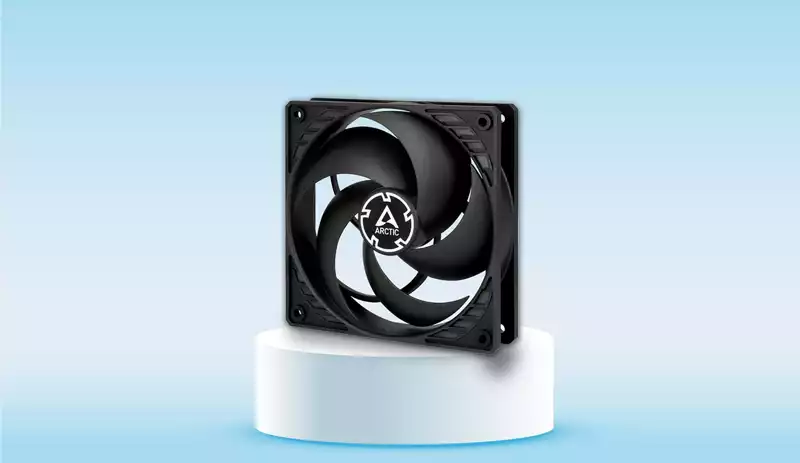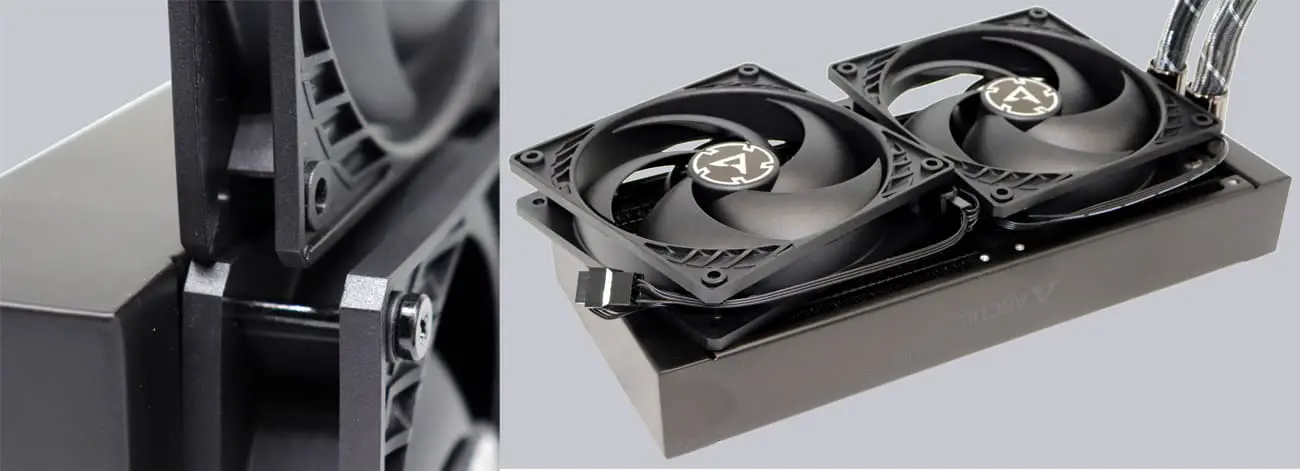You can also be interested in these:
- Noctua NH-L9a-AM5: Low profile cooler for Ryzen 7000
- Corsair AF120 RGB Elite full review
- Corsair iCUE H150i ELITE LCD XT full review
- Thermaltake Swafan RGB full review
This was a highly anticipated product in the case cooling fan area. The Artic company already has one of its products available for sale, which is perhaps the most innovative of the PCs ITX liquid cooling ones. We refer to the Arctic P12 SLIM PWM PST. We will evaluate its performance and see if it is really as good as it sells.

Arctic aimed to launch a new ultra-thin fan that would raise the stakes in terms of performance and loudness. Consequently, the Arctic P12 SLIM PWM PST is a fan that can rotate between 300 and 2100 RPM, with a resulting airflow of 42.1 CFM, a static pressure of 1.45 mmH2O and a loudness of 0.3 Sone.
This fan has a 400mm long cable with PWM and curiously a Splitter, while its motor has a fluid dynamic bearing or FDB. Its dimensions make it one of the thinnest on the market with its 120 x 120 x 15 mm of measurement and a weight of only 85 grams.
More in detail with this ventilation unit
Being more specific, the Arctic P12 SLIM PWM PST is made of high quality ABS plastic. This characteristic was to be expected since it is the same material all the fans of the P12 range are made.
Normally we see that ultra-thin fans are made of rigid materials to be able to have more resistance due to their thickness. The profile of the fan is smaller and the blades are more angled and thin, which makes them weaker.

On this particular fan, the finish and materials are acceptable. Meanwhile, and about the blades, it has 7 of them mounted on an axial fan, which supposes an outstanding performance with a high static pressure for a fan this slim.
The brackets that hold the central motor are quite thin, all except the one with the wiring. We assume this is so to offer less resistance to the air flow, coming out at a fairly prominent angle from the fan frame.
These supports flex very easily when handled. We might think that they can be split if we exert some force. The thickness of the fan is only 15mm, therefore the supports are comparatively reduced to their lowest expression to avoid vibration and firmly support the motor.
In the same way, the screw holes are not solid sockets. Instead, they are simply two plastic plates that twist if we apply a lot of force when installing. However, this feature can allow us a better management of the cables, having space to place them between the power supply and control.
In general terms the Arctic P12 SLIM PWM PST looks really good, to the point that we could say that we are in front of an outstanding product in the slim format. It should be noted that most of the competition fans are much more fragile.
Quality is something that is perceived at first glance. Likewise, the engineering work on the blades stands out, since with its short 10 mm its angle of action allows a magnificent air flow, not even protruding from the frame. The fact of including 7 blades helps to improve the flow and the static pressure in this type of fans.
The height of the blades reaches the upper cut of the motor, that is, the height of the central motor is fully occupied by the blades, which in the 25 mm thick version does not happen, since there are a few millimeters below to impact less in the air and improve the spinning aerodynamics of the motor.
Unrestricted fan performance
The Arctic P12 SLIM PWM PST has nothing to prevent it from performing at its best. It has noise levels of 34.4 dB, measured in a totally silent environment. The scalability of the sound and the speed of the air flow are excellent. This fan is capable of turning up to 2191 RPM, where it achieves 45.9 dB and 3.1 M/s respectively.
These are high-end 25mm fan figures, even premium. This is why we can say that this fan has an outstanding performance. In the performance data when we compare decibels with RPM we see almost a perfectly diagonal line. This tells us how well calibrated they are.
Still, we see some disparity in spikes or jumps in voltage. When we go from 7 to 12 volts there is a pronounced change from 2.1 M/s to 3.1 M/s. In terms of noise levels of 5 to 7 volts the noise output is homogeneous, but from 7 to 12 volts we can notice how the measurements are notoriously steep.

Even so, the information of the metrics of the fan spinning freely without restriction is quite satisfactory. The Arctic P12 SLIM PWM PST performs better than a 25mm fan. It is also worth noticing that this 12 volt fan is on par with an ML120 Pro at 7V (-600 RPM), and at 7 volts it is close to the Corsair SP120 HP with only 300 RPM more.
At 5 volts it is even more competitive, since it is comparable to the performance of a Nidec AP-15 with 400 RPM more. In this case there is only a 0.1 M/s difference, but if we compare it with the Noctua A12x25 it is almost the same performance. Amazing results from a slim product from this range.
As for loudness between 5 and 7 volts it is quite silent. At 12 volts its noise levels are already noticeable, but still they are not out of the ordinary. In the latter case, the noise it produces is at the level of the Noctua A12x35 with a little more RPM. Once again, amazing results for such a thin fan.
Restricted fan performance
When we have restriction in the Arctic P12 SLIM PWM PST does not start up to 50% of the PWM. However, at 40% the blades begin to turn, it is not enough to overcome the restriction of a TFC Xchanger 120 water cooling radiator of 60 mm and 11 FPI.
The scalability of the speed with the PWM is perfect, but if we check the performance data without restriction we will see that the speed has dropped a lot.
Noise level and RPM go hand in hand here too, but the truth is that, although the airspeed was an almost perfect diagonal in unrestricted tests, here the RPM leaves a slight curve, showing that it is a bit difficult to maintain. level.
This data is nothing to worry about. The performance of any fan in the ultra fine line is expected to have adverse effects when tested against the restriction of a radiator.
The noise levels in these cases do the opposite. The noise is dampened somewhat proportionally to the level of resistance. Likewise, this characteristic is comparable to 25mm thick fans.
Now, speaking in terms of airflow we see that it has an amazing capacity. In this sense the Arctic P12 SLIM PWM PST is at the height of the Scythe Kaze SLIM. At 5 volts and 7 volts it does not stand out too much, since the RPM it achieves is somewhat low. On the other hand, at 12 volts and with 2191 RPM it is not far from competitors much more serious and expensive. In the latter case, the fan is on par with the CM MasterFan Pro 120 AB, of which it remains at 0.3 M / s with less than 100 RPM more.
At 7 volts it also shows good performance, comparable to a Nidec AP60 with only 500 RPM more. On the other hand, at 5V it failed to overcome the restriction of the radiator.
The restriction of the radiator is not such a determining factor in loudness, but in performance. When it is subjected to resistance, it tends to have less static pressure, something that is assumed by its thickness, logically.
Gains or losses of performance and loudness comparing results with and without restriction
At 5 volts the tests indicate a loss of 100%, mainly because with restriction at that voltage the fan could not push air through the radiator, so it is 0.
At 12 volts the speed loss is 48.39% (restricted vs. unrestricted), a really good value for a 15mm fan. The best comparative value is at 7 volts, where the loss is only 42.86%, the third best of all available modes.
In noise levels the Arctic P12 SLIM PWM PST is very consistent. At 12 volts it manages to reduce its loudness with restriction by 0.4%, while at 5 volts it increases it by 0.3%. At 7 volts, which is its best performance range, it raises it by 1.8%. This data make this fan an excellent option in terms of loudness.
More stories like this
- Noctua NH-L9a-AM5: Low profile cooler for Ryzen 7000
- Corsair AF120 RGB Elite full review
- Corsair iCUE H150i ELITE LCD XT full review
- Thermaltake Swafan RGB full review
- Arctic Alpine 17 CPU cooling fan review
- Noctua NH-D12L review